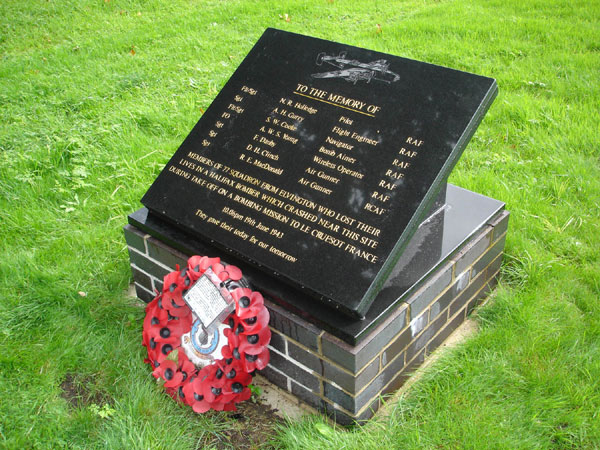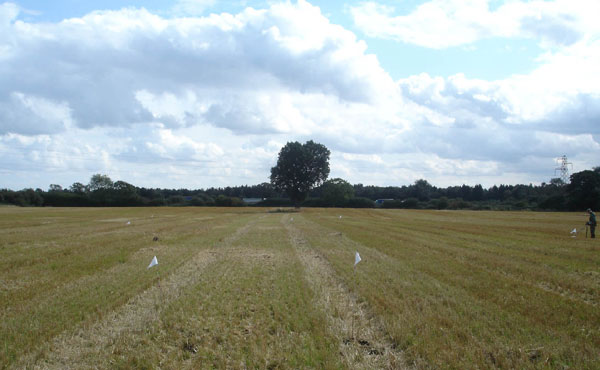Halifax JB863 near Heslington, York.
This 77 Squadron aircraft took off from Elvington at 22.04hrs on the night of 19th June 1943 for an operational flight to Le Creusot, France to bomb the Schneider factory. Immediately after becoming airborne the aircraft swung to starboard having only climbed to 300 feet. It then sideslipped into the ground two minutes after leaving the airfield and only two miles from the end of the runway. The aircraft was destroyed in the resulting crash and the crew stood little chance of survival. The crash was attributed to the failure of the starboard inner engine. In the 1950s the site was finally cleared of its bomb load which one assumes had buried itself at the time of the crash.
Pilot - F/Sgt Norman Reginald Holledge RAFVR (1331061), aged 22. Buried Hornchurch Cemetery, Essex.
Flight Engineer - Sgt Albert Henry Gurry RAFVR (1284804), aged 22. Buried Ilford Churchyard, Essex.
Navigator - F/Sgt William Cooke RAFVR (1339096), aged 21. Buried Windsor Cemetery, Berkshire.
Bomb Aimer - F/O Arnold William Stephen Young RAFVR (130565), aged 21. Buried Wembley (Alperton) Burial Ground, London.
Wireless Operator / Air Gunner - Sgt Francis Danby RAFVR (1310902), aged 26. Buried Anfield Cemetery, Liverpool.
Air Gunner - Sgt Desmond Henry Clinch RAFVR (1352806), aged 21. Buried Caerphilly (Penyrheol) Cemetery, Wales.
Air Gunner - Sgt Ronald Edwin MacDonald RCAF (R/131442), aged 20. Buried at Pocklington Burial Ground, Yorkshire.
Ronald MacDonald's grave in Pocklington. He was born on 2nd December 1921 in St.Catharines, Ontario, Canada and was the son of Ronald James and Dorothy Marie (nee Groves) MacDonald.
He lived in St.Catharines until 1936 when he moved to Miami, Florida, USA with his parents and finish his schooling there (possibly with his father's work as an accountant). He worked as a club attendant on Miami Beach until 1941 when he and his mother moved back to Canada. He enlisted for RCAF service on 17th October 1941 in Hamilton and after training received his air gunner's badge on 17th July 1942. He was posted overseas in August 1942 and trained at 20 OTU beginning 21st September 1942. He was then posted to 1652 HCU on 30th December 1942 and to 77 Squadron on 18th February 1943.
Francis Danby had lost a younger brother in RAF service on 27th June 1942, Alan Danby was serving with 405 Squadron and he and his crew were killed when Halifax W1175 crashed off the Dutch coast. The body of one of the crew was washed ashore and is buried in Holland. The remaining six of this crew are commemorated on the Runnymede Memorial.
Arnold Young's birth was registered in Fulham, London in 1921. He received a commission on 5th September 1942 to P/O on probation (emergency), rising to F/O on probation (war subs) on 5th March 1943.
The memorial sited on Fulford Golf Course dedicated on 21st September 2007.
Halifax JB863 was built to contract ACFT/1808/C4 by English Electric Co.Ltd. at Samlesbury and was taken on charge by 77 Squadron at Elvington as new on 16th March 1943. As a result of flak damage on the nights of 14th / 15th April 1943 and then on 29th / 30th May 1943 Cat.A/FB damage was the damage assessment each time that saw it twice repaired on site. On 19th June 1943 it had just taken off for an operational flight to bomb Le Creusot when it crashed near Heslington. Sadly all on board were killed. Cat.E2/FB Burnt damage was the damage assessment and it was struck off charge on 30th May 1943 having clocked up a total of 105.45 hours total flying time.
I visited the site in September 2008 with fellow air historians Ken Reast, David Thompson, Albert Pritchard and Eric Barton. Our time at the site was limited due to a thunder storm but it was long enough to find a scatter of pieces of the aircraft on the surface of the field to determine where it came down, and infact this is all the we ever wish to do on such visits. The site is today close to the main A64 York by-pass. We also visited the memorial to the crew located on Fulford Golf Course. Thanks to Mr Hawkswell, the landowner for letting us visit the site and for the help he was able to provide. The photograph above shows the general area of the crash whilst the piece below (although hard to make out) shows a Halifax part number with the prefix "59" referring to a part for the MkII Halifax variant along with an "EEP" English Electric Preston inspection stamp, that being the factory that JB863 was made.


Norman Holledge's birth was registered in Camberwell, London in 1921 and he married in the Romford area of Essex in 1942. His wife is listed as living in Hornchurch when he died but technically he was probably a Londoner hence why I have linked the two.


